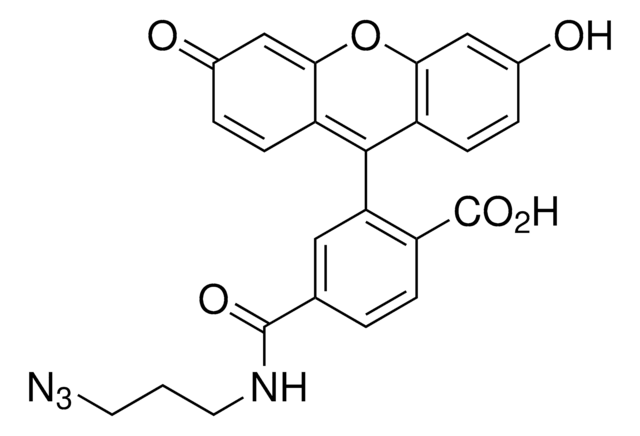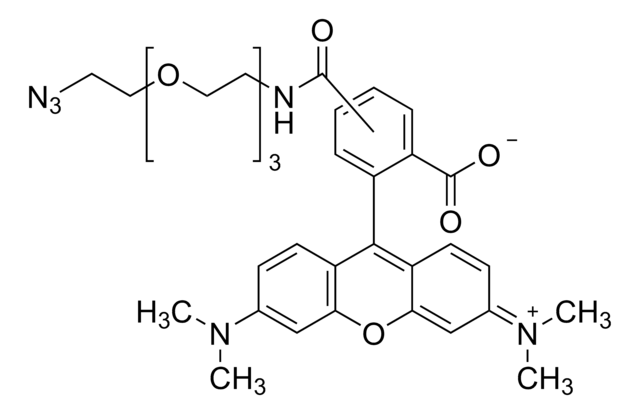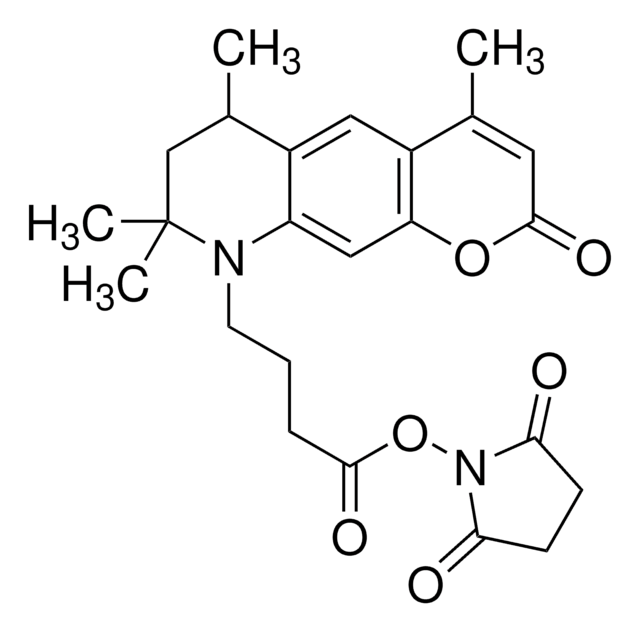68321
Atto 390 azide
BioReagent, suitable for fluorescence, ≥90% (HPLC)
Sign Into View Organizational & Contract Pricing
Select a Size
All Photos(1)
Select a Size
Change View
About This Item
Empirical Formula (Hill Notation):
C28H41N5O6
Molecular Weight:
543.66
MDL number:
UNSPSC Code:
12352125
PubChem Substance ID:
NACRES:
NA.32
Recommended Products
product line
BioReagent
Assay
≥90% (HPLC)
form
solid
manufacturer/tradename
ATTO-TEC GmbH
λ
in ethanol (with 0.1% trifluoroacetic acid)
UV absorption
λ: 380-384 nm Amax
suitability
suitable for fluorescence
storage temp.
−20°C
SMILES string
CC(CC(C)(C)N1CCCC(NCCOCCOCCOCCN=[N+]=[N-])=O)C2=C1C=C(OC(C=C3C)=O)C3=C2
InChI
1S/C28H41N5O6/c1-20-16-27(35)39-25-18-24-22(17-23(20)25)21(2)19-28(3,4)33(24)9-5-6-26(34)30-7-10-36-12-14-38-15-13-37-11-8-31-32-29/h16-18,21H,5-15,19H2,1-4H3,(H,30,34)
General description
Atto 390 is a fluorescent label with a coumarin structure. The dye is intended for application in the area of life science, e.g. labeling of DNA, RNA or proteins. Characteristic features of the label are high fluorescence quantum yield, large Stokes-shift, good photostability and low molecular weight.
The azide modification is suitable for reactions with alkyne groups (Huisgen reaction - “Click Chemistry“).
find more information here
The azide modification is suitable for reactions with alkyne groups (Huisgen reaction - “Click Chemistry“).
find more information here
Legal Information
This product is for Research use only. In case of intended commercialization, please contact the IP-holder (ATTO-TEC GmbH, Germany) for licensing.
Storage Class Code
11 - Combustible Solids
WGK
WGK 3
Flash Point(F)
Not applicable
Flash Point(C)
Not applicable
Choose from one of the most recent versions:
Already Own This Product?
Find documentation for the products that you have recently purchased in the Document Library.
Cuifang Kuang et al.
The Review of scientific instruments, 81(5), 053709-053709 (2010-06-03)
Stimulated emission depletion (STED) microscopy is one of the breakthrough technologies that belong to far-field optical microscopy and can achieve nanoscale spatial resolution. We demonstrate a far-field optical nanoscopy based on continuous wave lasers with different wavelengths, i.e., violet and
Simon Corrie et al.
Molecular bioSystems, 5(3), 262-268 (2009-02-20)
Herein we report a method for the detection of methylated CpG dinucleotides located within CpG islands in genomic DNA using multiplexed bead-based assays and standard flow cytometry instrumentation. Four CpG "clusters" were identified in the TFPI2 and SPARC CpG islands
Philip Howes et al.
Journal of the American Chemical Society, 132(11), 3989-3996 (2010-02-24)
Semiconducting polymer nanospheres (SPNs) have been synthesized and encapsulated in phospholipid micelles by a solvent evaporation technique. Four different conjugated polymers were used, yielding aqueous dispersions of nanoparticles which emit across the visible spectrum. The synthesis was simple and easily
Qiang Li et al.
The journal of physical chemistry. B, 115(46), 13643-13649 (2011-10-15)
Fluorescence resonance energy transfer (FRET) using biotinylated β-galactosidase (βGAL) as a donor and Alexa Fluor 350 (AF350) labeled avidin as an acceptor has been investigated by means of steady-state fluorescence and time-resolved fluorescence spectroscopy. The donors are readily paired with
Gerhild Zauner et al.
Chemistry (Weinheim an der Bergstrasse, Germany), 13(25), 7085-7090 (2007-06-20)
A fluorescence-based system to sense oxygen in solution is described. The method exploits the sensitivity of the endogenous fluorescence of type-3 copper proteins towards the presence of oxygen by translating the near-UV emission of the protein to label fluorescence in
Our team of scientists has experience in all areas of research including Life Science, Material Science, Chemical Synthesis, Chromatography, Analytical and many others.
Contact Technical Service






